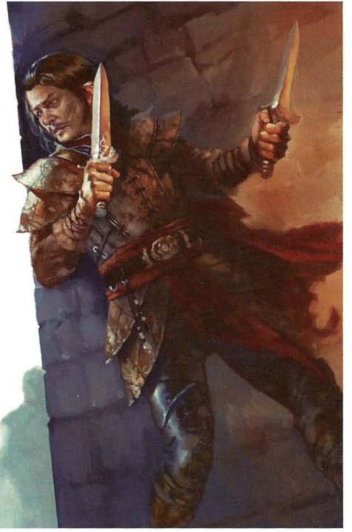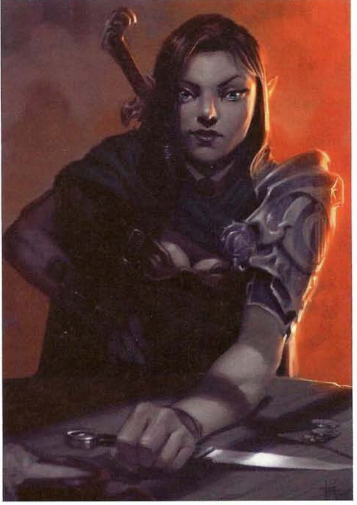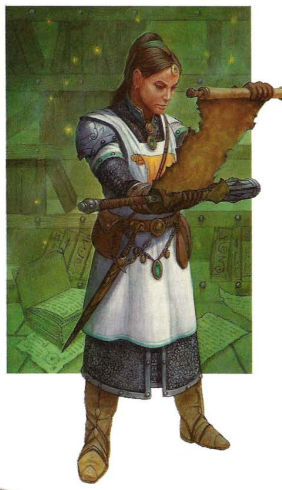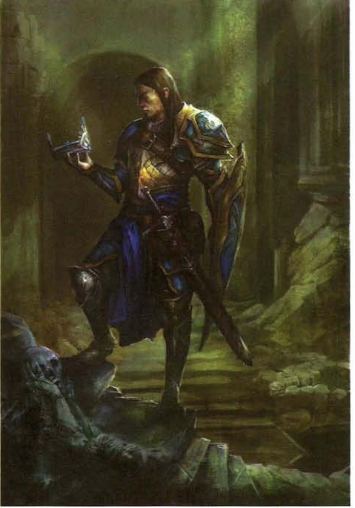Posts
-
Let's Read Neverwinter: Dead Rat Deserter

Copyright 2011 Wizards of the Coast. Luskan is a coastal city a ways north of Neverwinter. In the games, it was a pirate and thief-infested cesspool secretly ruled by a cabal of evil wizards. The evil wizards were defeated in a novel before the start of the events in this book, so now it’s just exactly what it always appeared to be.
The Dead Rats are currently the most successful thieves’ guild in Luskan. They have this name because their senior members are wererats, and their initiation ceremony involves a ritual that imparts some wererat powers to the initiate. Their leader is a halfling bard named Toytere, also known as “King Toy”, who seems to have the power to see the future and uses it to foil the many assassination attempts made on him.
A PC with this background used to be an average member of the Rats until they were brought in before King Toy, who proclaimed the PC was destined to lead a mutiny against him and ordered their execution. This was news to the PC, who barely made it out of the room alive and managed to abscond to Neverwinter.
Their original goal here was to build enough wealth and power to return to Luskan and take revenge on those who wronged them, but this might have changed by the time the campaign starts.
Dead Rat Deserter PCs are usually shifty and shady types, though they’re loyal to their friends (who include the other PCs). While rogues are the first to come to mind, there aren’t any class restrictions. Characters should be either humans, half-elves, or halflings, since those are the majority ancestries in Luskan and make up all of the Dead Rat membership.
The background skills for this theme are Intimidate, Stealth, and Thievery.
Features
You don’t need a theme just to make a shifty character with a shady criminal past, so why choose this one? Because it also lets you be a wererat!
The level 1 feature is Body of the Rat, an 1/round minor-action at-will power that lets the PC assume the form of a Tiny rat. The same power also lets them change back, and whenever they change shape they can also shift 1 square. In rat form, the PC can’t attack but gains a climb speed equal to half their ground speed and a +4 to Stealth checks. The PC’s equipment melds into the rat form, and continues to provide all of its passive benefits. There are a few exceptions: they don’t get AC bonuses from shields, can’t use active item powers, and can’t access any containers (like bags or potion vials). On the other hand, their equipment can’t be removed in any way while it’s part of the rat form.
At level 5, the PC gains a +2 power bonus to Stealth and Bluff. This is useful for a rogue-type, but would be much better if it was untyped.
At Level 10, Hybrid Bite lets the PC assume the classic hybrid wererat form. Changing back and forth is an at-will minor action, like above, and the character retains all their equipment and can use it normally. The hybrid form has the same size as the character. The character also gains a bite attack. The attack bonus for this is (STR or DEX modifier)+4, and the damage is 1d8+(same modifier) plus 5 ongoing damage (save ends). The bonus increases to +6 and the damage to 2d8 at level 21.
This attack is a little underwhelming, I think. If Strength or Dexterity is your main attack stat, it’s going to be about on par with a +2 weapon with a +2 proficiency bonus, which means it’s less accurate than the characters’s actual main weapon if any of those stats are better on it. Ongoing damage on an at-will is good, but also maybe not as good as the bonuses of a level 10’s character main weapon and class powers. If you use anything other than STR or DEX to attack, this power is useless.
Utility Powers
The optional powers here are all about tapping into your inner rat.
Savage Hiss is a level 2 encounter power that helps intimidate enemies in a fight. When the PC scores a critical hit, they can use this power to inflict every enemy within 5 squares with a -4 penalty to attack the PC for a turn.
Dead Rat Stealth is a level 6 daily power that takes a minor action and gives the PC a +2 power bonus to Stealth and Thievery for the rest of the encounter. If the PC dislikes a roll for one of these skills, they can end the effect and reroll it with a +5 power bonus.
Intuitive Leap is a Level 10 daily power that represents the PC inheriting some of King Toy’s prophetic abilities. The PC can use it when it’s time to roll initiative, gaining a +4 power bonus to the roll and being able to stand up or move their speed for free at that point.
Impressions
Mechanically, this theme suits high-Dex characters the best, since it boosts Stealth and Thievery and might let a character who lacks both to get access to one of them. Being able to turn into a normal-looking rat can enable all sorts of shenanigans, especially out of combat, but the hybrid form and bite attack are of dubious utility at best. This is not a theme that will do a lot to boost your damage output.
Story-wise, I haven’t gotten far enough into the book to see whether Luskan and the Rats influence Neverwinter in any significant way. It’s possible a Rat would just be along for the ride if they’re the only one in the party. An all-Rat party would result in a significantly different path than those implied by the other paths we saw so far. They all got set up together and would still retain their goal of getting rich and powerful enough to return and get some revenge, likely causing a lot of chaos in Neverwinter in the process.
-
Let's Read Neverwinter: Harper Agent

Copyright 2011 Wizards of the Coast. From what I remember, the Harpers used to be a “good conspiracy” back the “old days” of the Forgotten Realms. A secret society dedicated to doing good, fighting for freedom, and keeping the many evil factions of the setting in check. Elminster was a big fan, and several of the setting’s iconic NPCs were members.
Those Harpers got destroyed during the Spellplague, but sixty years before our narrative present a new group took up the name. This incarnation of the group is mostly focused on stopping the machinations of those Netheril survivors who came out of the Shadowfell, though they also have their fingers in other pies.
A PC with this background has a very specific and rather tense backstory. They always dreamed of joining the Harpers, and traveled to Everlund to apply. They were given a trial mission - to go to Neverwinter and link up with a woman named Cymril. Cymril was not only a fully-fledged Harper Agent but also the leader of the Sons of Alagondar. The Sons are a group of rebels who opposes Dagult Neverember, and who fight for an independent Neverwinter.
The PC gets included in night-time recon mission led by Cymril herself, and their group gets ambushed by a force of Neverember’s mercs. In panic, the PC hides, and then gets to witness as the rebels are massacred. The thing is, Cymril herself turned coat as soon as the fight started, and began killing her own underlings! In the end, the hidden PC is the only survivor on the rebel side: Cymril gets taken out by one of her lieutenants, who in turn dies to the mercenaries. They leave the rebels’ bodies on the street as a warning. Our PC as the foresight to steal Cymril’s Harper pin before absconding.
So the title of “Harper Agent” is kind of misleading. The PC is actually a rogue agent, sympathetic to the organization’s ideals but operating without their official support. The PC can’t let it become known that they’re not a real Harper, and even without that secret coming out they’re already facing suspicion from the very rebel group they were supposed to help, for being the only survivor of the ambush that killed Cymril.
A PC with this background wishes to discover the truth behind that massacre, prove their innocence, and fulfill their original mission of preventing Neverember from becoming the cutthroat merchant-king he wishes to be. This theme brings even more intrigue and spy games into the game than the Neverwinter Noble.
There are no class or race prerequisites, though the book recommends Harper characters be good at subterfuge and say many of them multiclass into bard, rogue, ranger or wizard.
Features
This class gains only a single feature: that Harper Pin pried from Cymril’s corpse. It marks the bearer as a member of the Harpers, brings with it a blessing from one of their patron goddesses, and can be used as a key to secret Harper hideouts and caches.
Mechanically, it’s a Rare Level 3 Wondrous Item, which means it doesn’t take up any slots and can’t be bought in stores. The PC chooses one of three possible blessings at character creation, and this becomes the pin’s item encounter power. Llira’s Grace lets them roll 1d6 and add it to an attack roll they just missed, potentially turning it into a hit. Mielikki’s Endurance lets them reduce incoming damage from an attack by 5 + half level. And Tymora’s Luck lets them re-roll a save with a +2 bonus to the new roll.
Utility Powers
This class’s optional utility powers continue to follow the themes of the divine blessings above.
Harper’s Healing Boon is a level 2 daily power that can be used as an interrupt when the PC is hit by an attack. They take only half damage from the attack and can immediately roll a save.
Unexpected Ally is a level 6 power that represents the PC use fast-talk to trick an enemy into believing the PC is a secret ally of theirs. This means the enemy can’t make opportunity attacks against the PC and grants combat advantage to them. The effect ends when the PC attacks the fooled enemy.
Resourceful Dastard (yes, with a D) is a level 10 daily power. It’s a stance that gives +4 to all defenses when the PC has cover or concealment, and lets them ignore all difficult terrain when shifting.
Impressions
This theme is very strongly oriented towards rogue, bard, or even ranger PCs, I feel. Its blessing and utility power can help make these characters less fragile and more mobile.
A criticism I’d make is that this one is a lot less generic than the other themes we saw so far. With a background like that, it’s a bit hard to make the PC anything other than a rogue Harper in the Neverwinter region of the Forgotten Realms. It’s also almost impossible to have more than one Harper Agent in a party unless you change that very detailed background and come up with another reason why they can’t contact out-of-town Harpers for support.
A Harper Agent in a party has reasons to cozy up to and aid the Neverwinter Noble, and provides a good hook for the GM to introduce the group to the Sons of Alagondar (or what’s left of them). Cooperation would not be automatic, since the Sons distrust the Harper, but it would be a start. The Agent would also try to convince any other neutral PCs to oppose Neverember.
-
Let's Read Neverwinter: Oghma's Faithful

Copyright 2011 Wizards of the Coast. Oghma is the Forgotten Realms god of knowledge and thought, occupying the roughly the same position as Ioun does in the default 4e setting. This particular PC is one of his worshipers, and for a while now they’ve been receiving dreams and visions from the god. These start as nightmares, but soon the threats are burned away by divine fire and the dreamer finds themselves in a grand hall where the sound of a water clock can be heard.
The meaning of these visions is clear: the faithful must go to Neverwinter and restore the House of Knowledge, a big temple to Oghma that was destroyed in the eruption. Neverwinter used to produce famously accurate water clocks, you see. This, and many of the city’s other lost craft secrets, could be restored from the temple’s archive, if it still survives. This would help the city’s reconstruction immensely, and of course bring the worship of Oghma back to the region in a big way.
This is about as lofty a goal as that of the Noble, though it’s much less concerned with secular politics. The Faithful is still going to need allies, and so has a ready-made reason to work together with any other PCs interested in restoring the city.
Oghma’s Faithful can belong to any race or class. Though the book says the theme fits divine characters better, the actual powers printed here surprisingly good for skill-monkeys from all power sources. Essentials Clerics can also pick up an Oghma domain, shown later. The theme’s background skills are History, Religion, and Streetwise.
Features
At level 1, the Faithful gains the Understand Language power, an encounter power that lets the PC choose a language they’ve heard or seen in the last 24 hours and become able to understand it until the end of the encounter. Outside of combat, that would be about 5 minutes, but as this is an encounter power you might as well consider the PC constantly able to understand that language during extended exploration sequences.
At level 5 the PC gains another power, Sudden Insight, which once per encounter lets them re-roll a skill check and take the second result. This is any skill, not just knowledge ones.
At level 10, they gain a +4 bonus to Perception checks made “to search”, which I guess means to actively search for something (such as traps, treasure, or the right book in the temple’s archive).
Utility Powers
As always, these become additional options when it’s time for the PC to choose utility powers.
Learned Response is a level 2 daily power that lets the PC use the result of an Insight check as their initiative for that combat. Even to me this feels a little too narrow in scope, but it does mean the low-Dex cleric will act much earlier once per day.
Bad Idea is a Level 6 encounter power which can be used as an interrupt when an adjacent creature attacks the PC. The PC slides the attacker 2 squares to another adjacent space, and inflicts a -2 penalty to its attacks and saves for a turn. Good for melee skirmisher-types like rogues or avengers. Clerics probably have something better to choose here from their class.
Tactical Inspiration is a level 10 encounter power that lets the PC shift 3 squares to be adjacent to an enemy as a move action, and also allow an ally within 5 squares to shift 3 squares for free. I could see a warlord or rogue taking this too, to help gain combat advantage earlier.
Impressions
This feels less spectacular to me than the Neverwinter Noble theme, as I’m not very enthusiastic about the FR pantheon. Mechanics-wise, it’s mostly about improving your skill checks, which can be awesome in the sort of campaign suggested by this book where you can have plenty of non-combat investigative and intrigue scenarios. It’s probably not going to do much for your combat effectiveness, though.
Multiple PCs with this background are very easy to accommodate in the same party, as they would all share a common cause and would have every reason to work together.

See? It's quite easy. -
Let's Read Neverwinter: Neverwinter Noble

Copyright 2011 Wizards of the Coast. Now that Neverwinter is on the way to being restored, Lord Dagult Neverember of Waterdeep has arrived to take control. He claims to be a distant relation of the old rulers of Neverwinter, and has declared himself Lord Protector of the city until “order is fully restored”. He’s backed by an army of mercenaries, and everyone expects him to crown himself king once he stamps out resistance to his rule and controls the whole city.
A lot of people suspect his claim to the throne is a lie. You are completely sure it’s bunk, because you are the true heir to the throne of Neverwinter.
You are the child of a noblewoman who escaped the city as it was being destroyed, shortly before you were born. She would succumb to her wounds and her grief shortly after having you, and you would be adopted by the Thann noble house in Waterdeep. You were given a proper noble education and consumed a steady diet of heroic poems and epics. They told you about your true heritage shortly after Dagult took over Neverwinter, and by the time the campaign starts you have decided to seek your birthright there.
This is a lofty goal, and a difficult one: you need strong allies, and the sort of conclusive evidence for your claim that can only be found in the ruins of the city. It’s up to you whether the other PCs know of your heritage or not.
Neverwinter Nobles must be at least part human, because the historical lords of the city were human. The powers suit melee defenders and give them a leaderly bent, but there are no hard class prerequisites. The background skills are Diplomacy and History.
Features
The level 1 feature is an extra encounter power named Take Heart, Friend!, which lets you use your lordly charisma to rally a comrade. It’s a minor-action encounter power that gives an ally within 5 squares a +2 power bonus to all defenses and 5/tier temporary HP. The “5/tier” bit means it would remain useful even after the projected level range for this campaign, which is a nice touch.
The level 5 and 10 features are less flashy, which follows the usual design formula for themes.
At level 5, when you flank an enemy your allies gain a +1 power bonus to attack that enemy. This does stack with the usual +2 bonus from combat advantage.
At level 10, you are probably close to claiming the throne and your regal mien is obvious for any to see. You gain a +4 bonus to Diplomacy when interacting with citizens of Neverwinter, and a +4 bonus to Intimidate against anyone who opposes your rule.
Utility Powers
These are not mandatory, as I’ve said earlier. Rather, they become additional choices alongside class powers whenever the PC would gain an utility power.
Honorable Challenge is a Level 2 encounter power that requires a minor action. It gives you an aura 2 that lasts a turn. Enemies inside take a -2 penalty to attack anyone other than you. In other words, it’s a wider Defender’s Aura that lasts for a single round.
Cover Your Ally is a level 6 encounter power. When an ally within 3 squares of you is attacked, and you are not a target of the attack, you can swap places with your ally as an interrupt, and become the new target of the attack. Castling!
Pillar of Lordly Might is a level 10 daily power. It’s a move action that gives you a +2 to all defenses and a +5 to Diplomacy, but also immobilizes you. This lasts for a turn but can be sustained with minor actions. Great for all those Thou Shall Not Pass moments, and it might even allow you to negotiate peace in the middle of a fight.
Impressions
I honestly don’t have a lot of skill at gauging the effectiveness of PC powers in 4e. These seem cool to me. They do work much better for melee defenders, and here they work equally well for Essentials and PHB classes. I like it that none of the powers involves attack rolls.
Regardless of the theme’s mechanical effectiveness, it gains major points for me because you get to become the ruler of Neverwinter if you follow the built-in story and succeed at it! Very few of the GMs I’ve known would just let a PC be the True Heir to the Throne if they asked it. Here, it’s just a character option anyone can take.
Technically, multiple characters in the party could take this theme. Perhaps the mother had twins, or perhaps you had multiple nobles who fled to Waterdeep with small or unborn children. This being 4e, I would not recommend using this as an excuse for deadly intra-party conflict. After all, Dagult Neverember is already there to provide proper opposition to the PCs. Rather, players of multiple nobles should probably agree on who has the actual claim to the throne and who “merely” stands to inherit an estate and become a trusted advisor to the monarch.
-
Let's Read Neverwinter: Character Themes Introduction
Chapter 2 - Character Options is the one players will be most interested in, and the reason the book strongly recommends creating new characters to play a Neverwinter campaign. It’s divided into four major sections: Character Themes, Racial Backgrounds, New Domains, and the Bladesinger class.
In this post, we’ll introduce the concept of character themes.
What is a Theme?
Character Themes are described here as the “third pillar” that defines your character alongside race and class. I also describe them as the “thing” you have in your Heroic Tier, just like Paragon Paths are the “thing” in Paragon and Epic Destinies are the “thing” in Epic. They were first introduced in Dark Sun, and I think we also got a few generic ones in Dragon before this point.
Here, themes are meant to give each character special knowledge and social ties that firmly ground them in the Neverwinter campaign. Unlike a character class, a theme is a thing that always exists and is acknowledged in the setting. People will never really call you “a fighter”, but they will definitely notice if you happen to be the lost heir to the throne of Neverwinter!
Aside from these narrative hooks, a theme also has several mechanical widgets. At levels 1, 5 and 10, you gain a Feature specified by your theme, which gets added on top of everything you already gain from your class. It gives you access to a few optional utility powers which you can take instead of a class power at levels 2, 6 and 10. And it also works like the backgrounds from the Dungeon Master’s Guide 2: each theme lists a handful of skills, and you pick one. If it’s already a class skill you get a +2 bonus to it. If it’s not you can make it into a class skill, and become able to choose it during character creation.
These features and powers can act to reinforce a character’s mechanical roles, or to broaden it in ways that weren’t possible before. The narrative bits can provide excellent reasons for the party to work together beyond the usual “you all meet in a tavern”. They’re not exclusive either. Several PCs can pick the same theme, and you could theoretically have a party where everyone does that. Some of the themes are better for this than others.
Technically, themes are entirely optional. A heroic-tier character without a theme would be just as viable. In practice, I’ve never seen anyone refuse to choose a theme once they became widely available. A hypothethical edition that refined the concepts of 4e would probably include them right in the PHB.
The next few posts will be dedicated to looking at the Neverwinter Campaign Setting themes in detail, and we’ll start with the most spectacular one.
subscribe via RSS